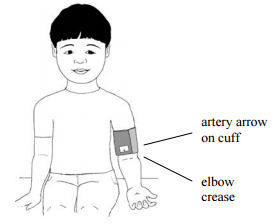Blood pressure measurement
What is blood pressure?
Blood pressure is a measure of the force of blood as it flows through the arteries.
Why does my child need blood pressure measurements?
The blood pressure measurements will help you and your doctor assess your child's condition and make decisions about his or her care.
How should I prepare my child?
Use simple words to explain why the procedure is needed. For example, "We need to check your blood pressure to see if your medicine is working."
Tell your child what is expected ahead of time, such as, "Your job is to hold still while I measure your blood pressure, so I get a good reading." This will help make it easier for both of you. Praise your child when you are done.
Have your child wear a loose-sleeved shirt and rest in a sitting position for 3 to 5 minutes before measuring the blood pressure. Rest the arm on a table so that it is supported at heart level. A quiet activity such as reading a book may help your child rest before the procedure. Make sure your child's legs are uncrossed.
How do I measure the blood pressure?
Your nurse will help you get the correct sized blood pressure cuff for your child, and teach you how to use it.
Getting ready
- Gather supplies:
- blood pressure cuff (automatic or manual)
- stethoscope (for manual reading)
- paper or notebook and pencil
- Squeeze all the air out of the cuff.
- Line up the artery marking (arrow) on the cuff with the front of the elbow. Wrap the cuff around the upper arm, directly on the skin (not over the sleeve). The bottom edge should be about one inch above the elbow crease.

- Wrap the cuff snugly against the arm, allowing enough room under the cuff so that two of your fingers can fit.
Follow the checked instructions below, depending on the type of cuff you have:
___ Automatic blood pressure cuff
- Turn on the machine according to directions. The cuff will automatically inflate and then deflate as it reads the blood pressure.
- The blood pressure machine will display two numbers when the reading is done:
- Systolic pressure (top number)
- Diastolic pressure (bottom number)
- Write down the blood pressure reading.
___ Manual blood pressure cuff
- Place the flat part of the stethoscope over the elbow crease, below the artery markings on the cuff. Hold gently in place.
- With your other hand tighten the screw on the bulb to close the valve. Squeeze the bulb quickly until the needle on the gauge is 20 to 30 points above where you expect the higher blood pressure number to be.
- Loosen the screw to release the pressure in the cuff at a slow, even rate (about 2 to 3 mm per second).
- Watch the gauge as you release the air.
As the needle falls, listen and note:
- Systolic pressure (top number) - the point on the gauge where the first clear tapping sounds are heard.
- Diastolic pressure (bottom number) - the point at which the sounds stop.
- When all sounds stop, deflate the cuff rapidly and completely.
- Write down the blood pressure reading.
Never leave the cuff inflated if you have to leave your child, even for a few moments.
How often should I check the blood pressure?
Check blood pressure at the times instructed by your child's doctor. Try to do it at the same times every day, and use same arm each time. Also check it if your child feels dizzy or light-headed, or has a headache. To measure the blood pressure again, wait 1 to 2 minutes between readings.
When should I call the clinic?
- if you are having trouble measuring the blood pressure
- if blood pressure does not respond to medicine
- for one or both of the following blood pressure readings:
(systolic) (diastolic)
What else do I need to know?
Follow the doctor's instructions about giving medicine for your child's blood pressure. See the discharge instruction sheet.
Keep a record: write down the readings as systolic/diastolic (example: 110/64). Also include the date, time, how your child felt at the time, and whether you gave blood pressure medicine. Be sure to bring the record with you to clinic appointments.
Questions?
If you have any questions, please call your clinic.
Children's Hospitals and Clinics of Minnesota
Last Reviewed 8/2015
This page is not specific to your child, but provides general information on the topic above. If you have any questions, please call your clinic. For more reading material about this and other health topics, please call or visit Children's Minnesota Family Resource Center library, or visit www.childrensmn.org/educationmaterials.
© 2024 Children's Minnesota
